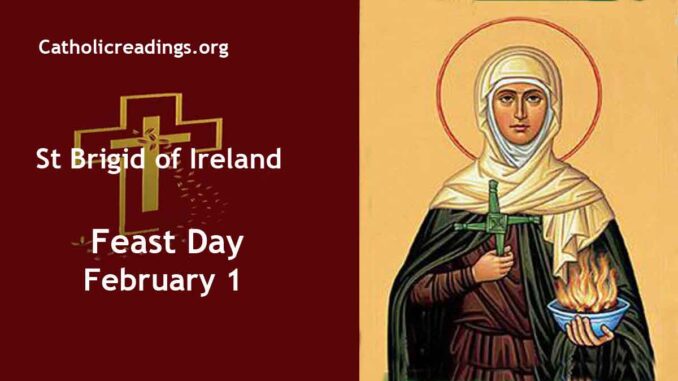St Brigid of Ireland was also known as Brigid of Kildare.
She is the patron saint of Ireland together with St Patrick and St Columba, and abbess of Kildare (Cill Dara).
She was born in 451 AD in Fochart, near Dundalk, County Louth, Ireland and died in 525 AD in Kildare, Ireland.
We celebrate her feast day on February 1 every year in the Catholic Church.
| St Brigid of Ireland Biography | |
|---|---|
 |
|
| Date of Birth | 451 AD |
| Place of Birth | Fochart, near Dundalk, County Louth, Ireland |
| Profession | Irish Nun |
| Place of Work | Ireland |
| Date of Death | 525 AD |
| Place of Death | Kildare, Ireland |
| Feast Day | February 1 |
| Canonization | Pre-Congregation |
| Patron Saint of | Patronage • babies • blacksmiths • boatmen • cattle • chicken farmers • children whose parents are not married • dairymaids • dairy workers • fugitives • infants • Ireland • mariners • midwives • milk maids • newborn babies • nuns • poets • poultry • poultry farmers • poultry raisers • printing presses • sailors • scholars • travellers • watermen • Douglas, Lanarkshire, Scotland • Ivrea, Turin, Italy • Leinster, Ireland • Kildare, Ireland, diocese of |
Saint Brigid of Ireland Life History
St. Brigid of Ireland, born to Dubtach, the pagan Scottish king of Leinster, and Brocca, a Christian Pictish slave baptized by Saint Patrick, had a unique upbringing.
Before her birth, her mother was sold to a Druid landowner, but Brigid remained with her until she was old enough to serve her legal owner, Dubtach.
Raised with high spirits and compassion, she was deeply influenced by Saint Patrick’s preaching during her childhood.
Her benevolence extended to those in need, and she often gave away items that belonged to her father, Dubtach, to help the less fortunate.
When Dubtach attempted to sell her, she defended her actions by expressing her belief that “Christ dwelt in every creature.”
Despite disagreements, a Christian king intervened, acknowledging Brigid’s virtue and preventing Dubtach from harming her. Ultimately, Dubtach granted her freedom.
Taking charge of her master’s dairy, Brigid’s generosity extended to distributing produce. The dairy flourished under her care, leading to the Druid’s liberation of her mother.
Rejecting an arranged marriage, Brigid sought to preserve her virginity and took her vows with Bishop Saint Mel of Ardagh.
Legends tell of her prayer to lose her beauty, granted until she made her vows and an amusing incident during her ordination by Saint Patrick.
In 468 AD, Brigid founded her first convent with seven nuns. Responding to bishops’ invitations, she established convents across Ireland, demonstrating her extensive travels.
She pioneered the concept of the double monastery, exemplified by Kildara on the Liffey River, accommodating both monks and nuns.
Saint Conleth became its first bishop, and this connection, along with the installation of a bell lasting over 1000 years, contributed to her patronage of blacksmiths and related fields.
St. Brigid died on February 1, 523 AD, in Kildare, Ireland. Her relics were initially interred in Kildare Cathedral, later transferred to Downpatrick, Ireland, in 878 AD, alongside those of Saint Patrick and Saint Columba of Iona.
Subsequently, her relics were rediscovered on June 9 1185, with her head eventually moved to a Jesuit church in Lisbon, Portugal.
Saint Brigid of Ireland is honoured as the Patron Saint for various individuals and places, including infants, blacksmiths, boatmen, cattle, chicken farmers, children of unmarried parents, dairymaids, dairy workers, fugitives, newborn babies, Ireland, mariners, midwives, milkmaids, nuns, poets, poultry, poultry farmers, poultry raisers, printing presses, sailors, scholars, travellers, watermen, as well as specific locations such as Douglas in Lanarkshire, Scotland; Ivrea in Turin, Italy; Leinster in Ireland; and the diocese of Kildare, Ireland.
Related Links
Powered By SEO Experts
Follow @ReadingCatholic
